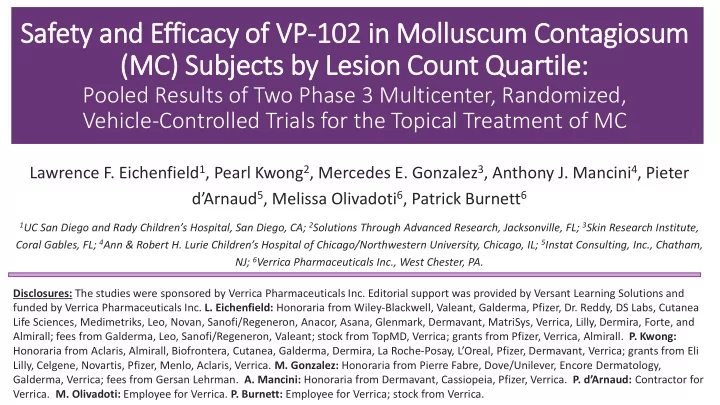

Safety ty a and E Efficacy cy o of VP VP-102 i in Mol ollu luscu cum C Contagio iosum (MC) S ) Subje jects ts b by Les Lesio ion C Cou ount Q t Quartile ile: Pooled Results of Two Phase 3 Multicenter, Randomized, Vehicle-Controlled Trials for the Topical Treatment of MC Lawrence F. Eichenfield 1 , Pearl Kwong 2 , Mercedes E. Gonzalez 3 , Anthony J. Mancini 4 , Pieter d’Arnaud 5 , Melissa Olivadoti 6 , Patrick Burnett 6 1 UC San Diego and Rady Children’s Hospital, San Diego, CA; 2 Solutions Through Advanced Research, Jacksonville, FL; 3 Skin Research Institute, Coral Gables, FL; 4 Ann & Robert H. Lurie Children’s Hospital of Chicago/Northwestern University, Chicago, IL; 5 Instat Consulting, Inc., Chatham, NJ; 6 Verrica Pharmaceuticals Inc., West Chester, PA. Disclosures: The studies were sponsored by Verrica Pharmaceuticals Inc. Editorial support was provided by Versant Learning Solutions and funded by Verrica Pharmaceuticals Inc. L. Eichenfield: Honoraria from Wiley-Blackwell, Valeant, Galderma, Pfizer, Dr. Reddy, DS Labs, Cutanea Life Sciences, Medimetriks, Leo, Novan, Sanofi/Regeneron, Anacor, Asana, Glenmark, Dermavant, MatriSys, Verrica, Lilly, Dermira, Forte, and Almirall; fees from Galderma, Leo, Sanofi/Regeneron, Valeant; stock from TopMD, Verrica; grants from Pfizer, Verrica, Almirall. P. Kwong: Honoraria from Aclaris, Almirall, Biofrontera, Cutanea, Galderma, Dermira, La Roche-Posay, L’Oreal, Pfizer, Dermavant, Verrica; grants from Eli Lilly, Celgene, Novartis, Pfizer, Menlo, Aclaris, Verrica. M. Gonzalez: Honoraria from Pierre Fabre, Dove/Unilever, Encore Dermatology, Galderma, Verrica; fees from Gersan Lehrman. A. Mancini: Honoraria from Dermavant, Cassiopeia, Pfizer, Verrica. P. d’Arnaud: Contractor for Verrica. M. Olivadoti: Employee for Verrica. P. Burnett: Employee for Verrica; stock from Verrica.
Background • Two Phase 3 clinical trials with identical protocols were completed using VP-102, a proprietary drug-delivery device combination containing cantharidin (0.7% w/v) for the topical treatment of molluscum contagiosum (MC). • This pre-specified exploratory analysis of pooled data aimed to determine whether lesion count at baseline affected safety and efficacy outcomes in VP-102 vs vehicle-treated subjects. • Subjects were separated into four quartiles by baseline lesion count (see figure, right.) Methods • Subjects 2 years or older were randomized 3:2 to topical administration of VP-102 or vehicle applied to all baseline and new lesions once every 21 days until clear, or a maximum of 4 applications. • Lesion counts were recorded by assessors blinded to the subject’s treatment group assignment at Days 21, 42, 63, and at the end-of-study visit (EOS) at Day 84. • Adverse events (AEs) were documented throughout the study with a specific focus on local skin reactions (LSRs), which were expected due to the pharmacodynamic action of cantharidin as a vesicant.
Baseline Demographics and Medical Histories Were Similar Across Quartiles • VP-102-treated subjects with higher lesion counts had a younger mean age, a shorter time since diagnosis, and a more frequent history of, or currently active, atopic dermatitis.
Efficacy Outcomes Were Similar Across Quartiles • There was an association between VP-102 quartile and • All VP-102 quartiles had statistically significantly higher separation from vehicle – the VP-102 quartiles with the clearance rates of all baseline and new lesions vs vehicle fewest lesions separated from vehicle earlier (p<0.05). (p<0.05). Complete clearance rates were similar across all VP-102 quartiles. Percentage of Subjects with Complete Percentage of Subjects with Complete Lesion Clearance at EOS/Day 84 Lesion Clearance By Time Point *
Safety Outcomes Conclusions • VP-102-treated subjects were similar in baseline • Selected treatment emergent adverse events (TEAEs) at the characteristics and MC medical histories across application site were similar across quartiles with VP-102 quartiles. treatment. • VP-102 groups showed a statistically significantly higher percentage of subjects with complete clearance in all quartiles compared to vehicle groups. • Pooled discontinuation of study drug due to AEs was 1.9% for VP-102 and 0.5% for vehicle groups. • Efficacy and safety outcomes were similar in VP-102 subjects regardless of quartile. • These data suggest that the number of MC lesions at baseline does not strongly impact efficacy and safety outcomes with VP-102 treatment.
Recommend
More recommend